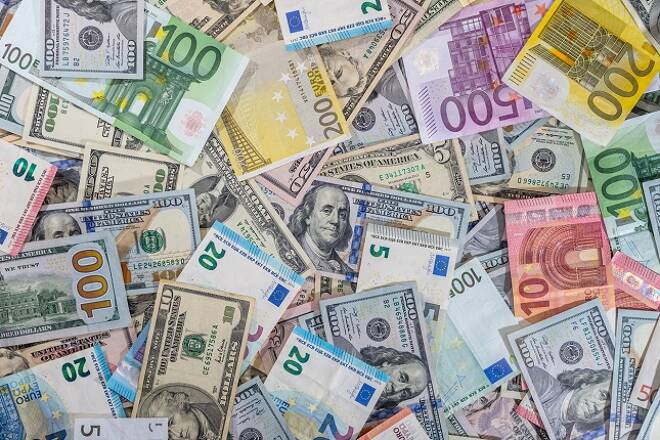Advertisement
Advertisement
EUR/USD Daily Technical Analysis for March 27, 2018
By:
The EUR/USD surged higher on Monday, hitting a fresh 5-week high, as the dollar lost ground and U.S. yield edged lower. The Fed’s will remain on hold for
The EUR/USD surged higher on Monday, hitting a fresh 5-week high, as the dollar lost ground and U.S. yield edged lower. The Fed’s will remain on hold for the balance of 2018, according to their most recent forecasts, released last week in the monetary policy meeting. French GDP moved up more than expected, which his a welcome change. The Bundesbanks Weidmann Says expectations for a 2019 hike are unrealistic.
Technicals
The EUR/USD moved higher on Monday surging up to a fresh 5-week high and poised to test the February highs at 1.2555. The exchange rate broke through trend line resitsance on heavy volume. Support on the currency pair is seen near the 10-day moving average at 1.2342. Momentum has turned positive as the MACD (moving average convergence divergence) index generated a crossover buy signal. This occur as the MACD line (the 12-day moving average minus the 26-day moving average) crosses above the MACD signal line (the 9-day moving average of the MACD line). The MACD histogram is printing in the black with an upward sloping trajectory which points to a higher exchange rate. The fast stochastic also surged higher reflecting accelerating positive momentum, but the current reading of 98, is well above the overbought trigger level of 80 and could foreshadow a correction.
The ECB’s Weidmann says Expectations for mid-2019 rate hike is not realistic
The Bundesbank President repeated that the ECB’s policy normalization should start soon, adding again that expectations for a rate hike around the middle of next year are “not unrealistic”. No real surprise there, although there seems a slight delay in the road map towards a rate hike, after Praet recently seemed to hint that he is comfortable with market expectations for a move “next spring”. If mega-hawk Weidmann is aiming more for the middle of next year, there doesn’t seem to be too much of a hurry, even if the general road map for the phasing out of policy measures remains intact, despite trade war jitters and market turbulences.
ECB expands list of QE eligible debt
In what looks like a move to ensure the smooth running of net asset purchases through the final stretch of QE, the Bundesbank asked the ECB to include 7 regional German agencies to the list of institutions whose debt is eligible for purchases under the QE program. There have been several warnings that the ECB would run out of eligble assets and the latest move will go some way to ensure that the program runs smoothly through to the end of the year, when we expect net asset purchases to be phased out.
French Q4 GDP was revised Higher
French Q4 GDP revised up to 0.7% quarter over quarter from 0.6% reported initially. The annual rate was left unchanged at 2.5% year over year. The breakdown showed strong export growth, which at 2.5% quarter over quarter, far outstripped import growth of 0.3% quarter over quarter, with export growth reaching 5.1% year over year. Capital investment jumped 1.1% quarter over quarter, and was up 4.7% year over year, while household spending actually trailed behind with a meagre growth rate of 0.2% quarter over quarter. So a divergence from the usual pattern of expansion in the French economy. Especially the pick up in investment is a welcome development.
Fed custody data showed a decline in Treasury holdings
Fed custody data showed an $11.6 billion decline in Treasury holdings in the week ended March 21. Additionally, there was a $16.7 billion decline on the Wednesday-to-Wednesday figure. And indeed, yields were up a handful of basis points across the curve over that time span. The timing is interesting, coming just ahead of the FOMC decision and amid heightened volatility. However, these are the first declines in holdings on both those statistics since January 24. Over that time frame, average Treasury holdings had risen just over $100.3 billion, and were up $95.4 billion. The Fed of course provides no information on individual country flows, so we won’t know specifics. And there are several factors that go into the weekly changes, including managing foreign exchange needs, along with political tumult.
About the Author
David Beckerauthor
David Becker focuses his attention on various consulting and portfolio management activities at Fortuity LLC, where he currently provides oversight for a multimillion-dollar portfolio consisting of commodities, debt, equities, real estate, and more.
Did you find this article useful?
Latest news and analysis
Advertisement
